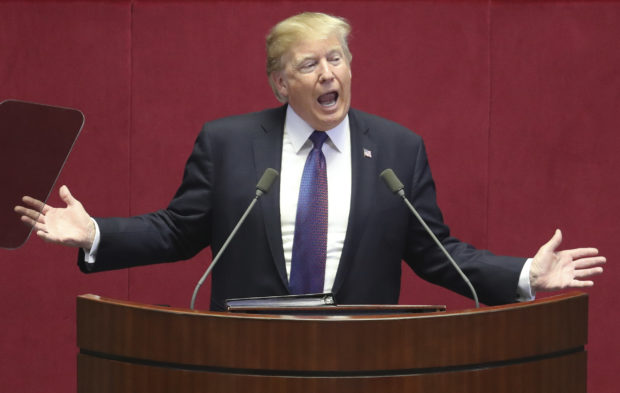Trump and the Korean DMZ: A surprise that wasn’t to be

US President Donald Trump addresses the National Assembly in Seoul on November 8, 2017.
Trump’s marathon Asia tour moves to South Korea, another key ally in the struggle with nuclear-armed North Korea, but one with deep reservations about the US president’s strategy for dealing with the crisis. / AFP PHOTO / Lee Jin-man
SEOUL — It was the big surprise that was not to be.
Donald Trump, America’s showman president, hatched a secret plan to visit the Korean Peninsula’s demilitarized zone (DMZ) before he ever left Washington last week on a five-nation tour of Asia.
Trump teased a showstopper during a toast at a state dinner held in his honor in Seoul on Tuesday night, promising: “We’re going to have an exciting day tomorrow for many reasons” that “people will find out.”
With reporters sworn to secrecy and a beefed-up security retinue in tow, his helicopter took off in the dim early morning light on Wednesday bound for the heavily fortified border.
Press Secretary Sarah Huckabee Sanders had announced the destination by scrawling the letters “DMZ” on a notepad, saying that was how she was told to communicate the sensitive information.
Article continues after this advertisementPower play derailed
Article continues after this advertisementBut plans for the grand reveal were botched by Mother Nature, and Sanders described Trump as disappointed — and “pretty frustrated.”
The snafu is a particularly humbling moment for a win-focused president, who found his DMZ power play derailed by weather.
Just after daybreak, Trump’s motorcade departed unannounced for Yongsan Garrison, a US Army base in Seoul.
A fleet of military helicopters was standing by for the roughly 56-kilometer flight to Observation Post Ouellette, the closest post to the 1953 armistice line.
Trump traveled in an air convoy, consisting of two identical VH-60Ns — Marine One and a decoy — and three Chinooks carrying press, aides and heavily armed security.
But visibility below 1.6 km and misting conditions aborted the plan.
As they neared the DMZ landing site, the pilots were unable to see the other helicopters around them, Sanders said.
Military pilots and the US Secret Service decided it was unsafe to continue, and the helicopters returned to Yongsan.
Waiting in limousine
Undeterred, Trump waited nearly an hour in his armored limousine near the helicopters in hopes of a clearing in the weather.
Just before 9 a.m., the final call was made: The stop was off. Trump’s 11 a.m. address to the South Korean National Assembly could not be delayed.
Trump was set to depart Seoul for China, after the National Assembly address.
The elaborately choreographed arrival ceremony in Beijing, which has been timed to sunset, meant Trump could not afford to visit the DMZ later on Wednesday.
In advance of the 12-day trip, White House officials had publicly dismissed the idea of a visit to the DMZ as “a little bit of a cliché.”
But behind the scenes, Trump made it clear to aides that he intended to follow through with the presidential rite of passage.
Shrouded in secrecy and symbolism, presidential visits to American troops stationed in South Korea and the DMZ have become a staple of trips to the peninsula for decades.
Every president since Ronald Reagan has visited the 1953 armistice line, except for George H.W. Bush, who visited when he was the vice president.
“For [South Korean] President Moon [Jae-in] and President Trump to go together would have been historic, it was supposed to be a symbol of the strong alliance,” Sanders said. “I think the fact that they were both planning shows the importance.”